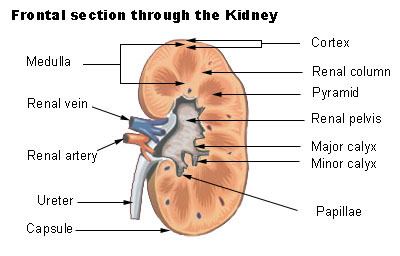ICD-9-CM 584.7 MedlinePlus 000488 | ICD-10 N17.2 DiseasesDB 9572 eMedicine med/2839 radio/523 | |
 | ||
Renal papillary necrosis is a form of nephropathy involving the necrosis of the renal papilla. Lesions that characterize renal papillary necrosis come from an impairment of the blood supply and from subsequent ischemic necrosis that is diffuse.
Contents
Signs and Symptoms
Symptoms (and signs) consistent with renal papillary necrosis are:
Causes
In terms of cause, almost any condition that involves ischemia can lead to renal papillary necrosis. A mnemonic for the causes of renal papillary necrosis is POSTCARDS: pyelonephritis, obstruction of the urogenital tract, sickle cell disease, tuberculosis, cirrhosis of the liver, analgesia/alcohol abuse, renal vein thrombosis, diabetes mellitus, and systemic vasculitis. Often, a patient with renal papillary necrosis will have numerous conditions acting synergistically to bring about the disease.
Analgesic nephropathy is a common cause of renal papillary necrosis. The damage is cumulative and most patients of renal papillary necrosis would have ingested at least 2 kg of analgesics in the past. The risk is higher for phenacetin (which was withdrawn from market in the United States) and paracetamol (acetaminophen) compared to aspirin and other NSAIDs.
Pathophysiology
The pathophysiology of this condition can be due to analgesic nephropathy, which in turn is a result of long-term use of aspirin. It is a sequence of vascular occlusion, vasospasm, then infection and finally obstruction which leads to RPN.
Diagnosis
Individuals with renal papillary necrosis due to excess use of analgesic have an elevated risk of epithelial tumors, hence a urine cytology exam is useful. In terms of imaging this condition can be identified by retrograde pyelography (RGP). The diagnosis of renal papillary necrosis is therefore done via:
Treatment
Treatment of renal papillary necrosis is supportive, any obstruction (urethral) can be dealt with via stenting. This condition is not linked to a higher possibility of renal failure. Control of infection is important, thus antimicrobial treatment is begun, so as to avert surgery (should the infection not respond).
